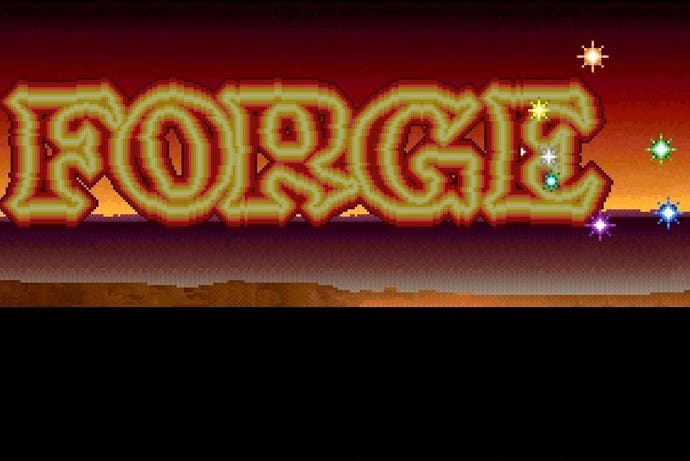The twin tales of Forge, Loom's forgotten follow-up and its fan-made sequel
Fruits of the Loom.
When Gabriele Nannetti agreed to work on Forge , he was entirely unaware of what the project entailed. The soft-spoken Italian game designer, known online as Abisso, responded to a forum post by a Canadian named Duke Davidson, requesting aid from volunteer programmers, artists, sound engineers and so on for a new project. "He didn't mention anything about Loom," Nanetti says. "He wanted some help on game designing, because he wasn't very experienced."
"I was mainly out of the game at that point. The last game I did was in 2005. But I wanted to get back on track so I answered the post. Then, only then when we spoke after a while, it turned out he was doing a Loom sequel... and the funny thing is that I had never played Loom."
At this point in our discussion, Nannetti laughs. "I'm not one of those guys who tries to do the game they loved so much in their childhood."
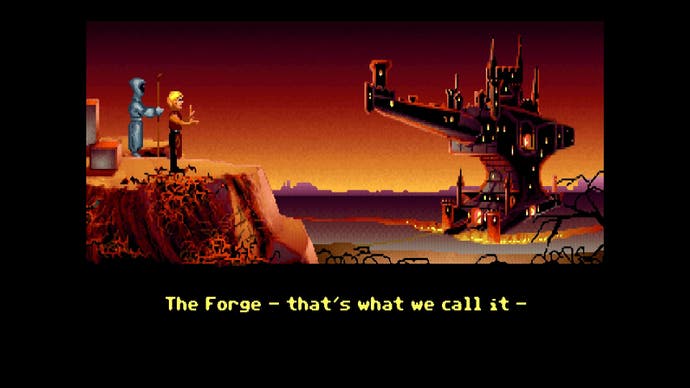
Nannetti ended up leading the Forge project, and has been working on it for the last six years. It isn't finished. Nannetti doesn't know when it will be finished. For the second time in 25 years, the sequel to Loom is stuck in limbo.
One might argue this marks the third such occurrence, because limbo was where the first hints of Forge were visible. Loom concludes on an ambiguous note. Bobbin Threadbare thwarts the spectre of Chaos by destroying the eponymous device that has left the fabric of reality in tatters, and escapes through the last remaining void with his Weaver brethren, carrying that final tear into a moonlit sky.
"Loom was conceived as the first in a potential trilogy of games: Loom, Forge and The Fold," says Brian Moriarty, creator of Loom. "The ending of Loom was written to suggest the possibility that the stories of Hetchel, Rusty and Fleece might be continued. But there was no firm plan to actually make any sequels after Loom was done. I was too exhausted to think about it."
The Fold was never more than a twinkle in Moriarty's eye. But LucasArts did begin producing Forge, and although Moriarty's involvement in the development was minimal, it was his vision Forge followed.
Forge continued the story of Loom from the perspective of Rusty Nailbender, the sleepy blacksmith who Bobbin accidentally kills by setting a dragon on him, and then resurrects later in the game. "Near the end of Loom, Chaos gains control of the Great Forge of the Blacksmiths and enslaves the guild," Moriarty says. "The second game was going to tell the story of Rusty's attempt to regain control of the Great Forge and free his friends, including his father, the head of the guild."
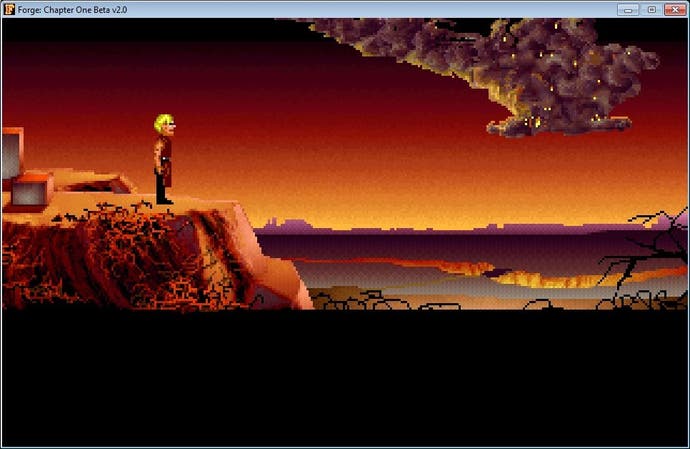
Rusty's tale would have introduced new guilds to Loom's world, and Moriarty thought the game should conclude with a "gigantic" battle-scene. "I also liked the idea of Bobbin appearing once or twice as a ghostly apparition, offering advice and encouragement to Rusty."
Visually, the game would move away from Loom's relatively pastoral setting adopting a medieval industrial look with "lots of fire, smoke and metal, rendered in amber, grey and black." In terms of mechanics, Moriarty intended to continue with Loom's musical systems, but in line with the blacksmith theme and "using percussion instruments."
Moriarty never saw those ideas bear fruit. Once Loom was complete, he moved on to a completely different project, a set of educational games based on the Young Indiana Jones TV series. "I was physically separated from the rest of the games group during this period. I'd heard rumours that a few people were exploring design ideas for Forge. But I never saw any of their work, and have no idea how far they got before the project was cancelled."
Precisely how far post-Moriarty Forge was pursued is unknown, although we do have some snippets of information. A design document was put together by Kalani Streicher and Mike Ebert. Dated March 22nd 1990 (two months after Loom's release) it outlined Rusty's journey and how the game followed on from Loom. What's more, in an interview last year about cancelled LucasArts games , Day of The Tentacle co-designer Dave Grossman suggested that some art was done for the project. At 640x480 resolution, it would have been double that of Loom.
What is certain is that by 1994 Forge was dead in the water. At some point during a reorganisation of the company, which included purging many producer roles, Forge was cancelled, and LucasArts focussed upon troubled project The Dig. Forge returned to limbo, and remained there for 15 years.

In 2009, interest in Forge began to bubble again. Not within LucasArts, but among a group of fans. Led by Duke Davidson and Gabriele Nannetti, these enthusiast developers came together under the name Quill o' The Wisp. Davidson's initial ideas took several forms; a game based on Loom's audio-drama, an interactive video and a prequel to Loom. "And then he decided, 'why shouldn't I do something new, a sequel?'" Nanetti says.
The nature of Forge makes it particularly unusual amongst fan projects. By now we're familiar with the concepts of fan remakes like Black Mesa Source or Command and Conquer: Renegade X. But Forge is an unofficial sequel to one game based on another game that didn't happen. Not only that, it was being co-developed by someone who had never played Loom in the first place.
This was Nannetti's first task once he joined the project, and he promptly fell in love with Loom. "I decided to devote much more than what I had planned of my time to the sequel," he says. "The team lacked almost everything, Duke had some artists and that's it. So since I knew the engine I proposed that I'd be programmer as well."
Nannetti used Adventure Game Studio as the basis for Forge, and has been the only programmer on the project since its inception. In other areas, such as art, sound, and animation, Forge has been built by over fifty people. "We had a lot of little contributions from artists, many of them offered to help and then only did like a couple of items maybe. A couple of animations, or one background, something like that," Nannetti says.
Such a broad yet shallow pool of volunteers has made consistency a real challenge. This situation was compounded when, 18 months down the line, Davidson was forced to leave the project due to personal reasons. Consequently Nannetti took sole charge of Forge. "Every time I had to look for other people to help, [I had] to explain to them what were the guidelines they were to follow," he explains. "I resorted to do some things myself is because I actually noticed I was wasting much more time to find someone else, bring him in, do the briefing and receive the result."
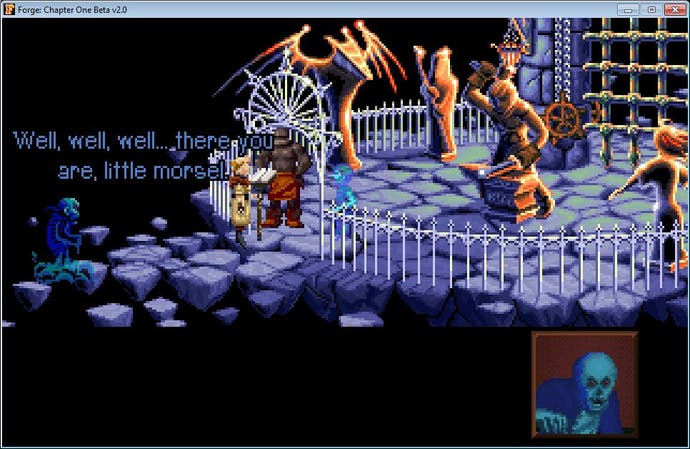
This is not to say Nannetti is ungrateful for the huge amount of help he has received during the project. He is especially happy with Forge's music, around 80 per cent of which he estimates was done by one person. He's similarly pleased the voice-acting, particularly the work of professional actor Dylan Jones. "He recorded for free like 3000 lines of speech. And it's just a third of the game, actually."
Running alongside the problem of consistency was the issue of authenticity; how much should their unofficial version of Forge resemble the official version of Loom? Plot wise, Forge would follow Moriarty's basic outline; Rusty's fight for the Forge, and would only use guilds mentioned in the Book of Patterns which shipped with Loom back in 1990.
Authenticity was a particular sticking point in two areas, visuals and mechanics. For the former, Nannetti decided to adhere as closely as possible to Forge's original aesthetics, going as far as to have the backgrounds painted in Loom's original resolution: 320x240. "The fact it's low-res actually doesn't help at all," Nannetti says. "It's much, much longer as a process. You can't use filters, basically. You don't have to place each pixel individually, but you have to use lines or the colour filler. But no big strokes, no filters, nothing like that."
With mechanics, Nannetti took the opposite approach. Initially he planned to do something music-based in the vein of Bobbin's distaff, which had you cast spells by playing a sequence of musical notes. But he decided that this didn't fit so well with the more practical Blacksmith theme. "To have a working graphical user interface, I thought it might be nice to have the player actually draw these things on the screen, and the effect applied."
This led to the creation of Rusty's gauntlets, which the character uses to draw schematics of objects in the game world, influencing them in various ways. It's a lovely counterpoint to Loom's distaff, visual instead of aural. "The concept is not completely new. But it's nice in my opinion to have it apply to how Rusty interacts with reality," Nannetti says.
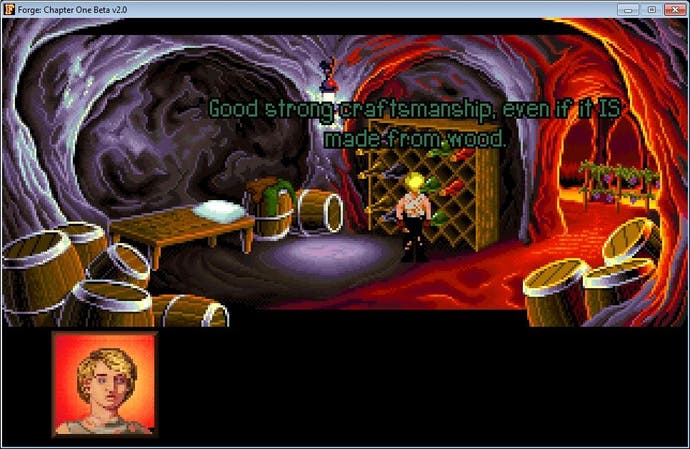
So far, Quill o' The Wisp's work demonstrates a lot of potential. There are rough edges - the odd flatly-acted line or clashing character art - but they're minor flaws. The first chapter is available to download for free online, and Nannetti tells me that the second and third chapters are more or less complete. It appears to be quite a lengthy game, which is interesting given Moriarty designed Loom specifically to be brief.
Unfortunately, in the last year or so Quill o' the Wisp's work has slowed to a crawl. The economic situation in Italy has forced Nannetti to take on additional work, leaving him with much less free time to spend on the game. He has considered running a fundraiser to kickstart the final stages of development. But throughout the project he has been reluctant to accept any money for Forge due to potential copyright issues. "We feared that copyright owners could send us a cease and desist letter. That actually happened. Not for LucasArts games as far as I know, but it happened with Sierra and Sega."
For the moment, it looks unlikely that we'll see a complete sequel to Forge in the near future. But Nannetti certainly hasn't given up on the project. In a way, neither has Moriarty. During his 25th anniversary GDC lecture on Loom, he described not pushing onward with Forge as the biggest regret of his life, and suggested three professional studios he would trust to make Forge now - Telltale, DoubleFine and WadjetEye, the creators of the Blackwell series.
But what does the creator of Loom think of Quill o' the Wisp's efforts? "I played the first chapter of the fan sequel, and was impressed. It's remarkably polished, with excellent music and voice acting, and contains some really fine moments. I hope they get to finish it."
